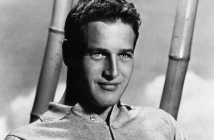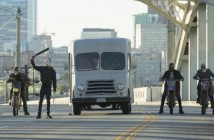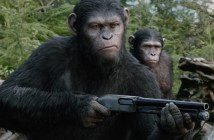10. The opening scene of ParaNorman
The enormously likeable and poignant ParaNorman begins like the equally-loving parody trailers from Grindhouse, with a silly but impressive homage to bad late-night zombie movies shown on TV (titled with the production studio name “Laika”), complete with clumsy editing, a visible boom mic, hints of cheesecake, and poor acting, with even some genuinely non-referential jokes thrown in for good measure. The stop-motion animation is both cartoonish and palpably three-dimensional, an engaging hybrid that works just as well as the mixture of humor and horror at the heart of the film’s success. The brain-eating monsters that morbid but moral adolescent Norman (Kodi Smit-McPhee) watches collectively turn out to be a more suitably imaginary outlet for his interests than the everyday world, where he’s gifted/cursed with the ability to see ghosts. This power even provides a nifty reversal of a punchline to the opening sequence, which besides introducing his disbelieving family also features some masterfully designed facial expressions in Norman’s enthralled television viewing.
9. The prison dance in Samsara
The Baraka duo of Ron Fricke and Mark Magidson came out this year with another narration-less travelogue, Samsara, a breathtaking mixture of the sacred and the profane, the holy and the human. Several sequences stand out, but one that’s both fascinating and entertaining is the heavily choreographed performance by the prisoners at the Philippine Cebu Provincial Detention and Rehabilitation Center in a calisthenics program whose dances have been heavily deployed to YouTube. With an inspiring and professional level of energy, the prisoners, shown with graceful camera movements both in their cells and in the relative freedom of the courtyard, express themselves wholeheartedly. The film captures several other sequences of equally physical beauty, whether religiously-motivated dances or the sped-up activities of human groups on a large scale. Yet the prisoners’ collective routine, reportedly cued to an MC Hammer song but scored in the film by Michael Stearns, is a rousing and thought-provoking chunk of nonfiction bliss.
8. Old Seth loses himself in Looper [YouTube link]
It’s crucial that a time-travel movie keep us invested in its narrative conceits, even if retrospection may reveal previously-unaware cheats and paradoxes. The most eerie scene of Rian Johnson’s Looper concerns (without getting too bogged into details) the future self (Frank Brennan) of young assassin Seth being granted an escape from his ordained would-be “suicide” from the hesitation of his present self (Paul Dano). Protagonist Joe (Joseph Gordon-Levitt) betrays his friend to their criminal organization who captures young Seth. In a frighteningly wordless sequence, old Seth has arrived at the train yard that promises freedom but discovers a newly-appeared message carved into his arm: directions and a deadline from his bosses to return, marked into his young self that have trickled up through this timeline. Moments later Seth begins to discover amputated fingers, a hacked-off nose, and other disappearing appendages. The disturbing repercussions of time-travel turn physical as if in a noir version of Marty McFly’s vanishing family photograph in Back to the Future. When he finally arrives at his destination, he’s little more than a hunk of flesh; as he’s summarily dispatched, a brief glimpse of the hinted-at medical procedures on his kidnapped young self closes both the sequence and Seth’s loop permanently.
 7. Monologue in The Turin Horse [Russian-dubbed YouTube link]
7. Monologue in The Turin Horse [Russian-dubbed YouTube link]
Béla Tarr’s purportedly final film (co-directed by Ágnes Hranitzky) is the apocalyptic Turin Horse, a bleakly beautiful extension of an anecdote about Friedrich Nietzsche’s commiseration with a whipped horse. Tarr, Hranitzky, and frequent collaborator László Krasznahorkai imagine the brutal routine and daily existence of the horse’s owner and the owner’s daughter, told mostly in silent long takes except for howling winds and a repetitive score. Among the infrequent visitors to the duo’s home is a forthright neighbor (Mihály Kormos) who’s run out of pálinka and wants more but when invited in delivers an excoriating one-take monologue about the ills of the world and mankind’s debasement of the virtuous and the beautiful. Breaking the verbal silence, this rambling diatribe is a tonic of woozy bitterness, yet Fred Kelemen’s camera seems initially more interested in the brute fact of the daughter’s refill of the pálinka bottle until it can’t help but be pulled by the visitor’s drunkenly compelling gravity. Kormos’s face is gloriously expressive, a perfect vehicle for the monologue’s venom as well as his unexpected nonchalance when the father (János Derzsi) basically calls him on his bullshit. The visitor’s is just one of the perspectives on the state of our fallen world espoused in Tarr’s sumptuous film.
6. The ghost ship in Tchoupitoulas
Tchoupitoulas is a one-of-a-kind documentary marvel that thrusts you headlong into the New Orleans night, a tale told through the eyes of three young brothers and shot, directed, and edited by filmmaking duo Bill and Turner Ross. Ostensibly a nighttime odyssey prompted by the native brothers missing their ferry home, the film is really a sensuous city symphony of light and music, heavily indebted to the organic flavors and colorful characters the group finds along the way. In an alternately unsettling and celebratory sequence, the kids come across a derelict ship (that turned out to be the defunct Mississippi Queen) with its lights still mysteriously powered. Rushing onto the boat with an air of unbridled adventure, the boys play scary jokes on each other while the camera soaks in the otherworldly beauty of the empty vessel, a shell to be filled with one’s own imagination. Alongside several powerfully entertaining musical performances and quiet but haunting absorptions of French Quarter atmosphere, the journey aboard the “ghost ship” is a special highlight.
5. The hotel room fight in Haywire [YouTube link]
2012 was a stellar year for brutal on-screen fights: fast-paced but spatially-coherent examples abound in The Raid: Redemption, Universal Soldier: Day of Reckoning, and Sleepless Night, but especially Steven Soderbergh’s showcase for female MMA fighter Gina Carano, Haywire, features several of the year’s best. As covert operative Mallory Kane, Carano has a startling physical presence and ably goes toe-to-toe with Channing Tatum, Ewan McGregor, and Michael Fassbender. It’s this last knock-down, drag-out free-for-all that’s my favorite fight of the year, a sweaty sexualized romp through a Dublin hotel room between Kane and an MI6 agent-turned-betrayer posing as her husband (Fassbender). The martial arts-inflected stunt work is crisp and no-nonsense, shot from shifting vantage points only to replicate the speed and rhythm of the fighters. The only sounds are breathy grunts, bodily thumps, and smashed objects. Despite being handsomely dressed, having returned from a party where they met their contact, the combatants’ struggle devolves into an erotic leg choke-hold on the hotel bed. Under differing circumstances, one could imagine this physically-matched couple still falling into bed but with ultimately more pleasant results.
 4. Freddie’s first processing in The Master
4. Freddie’s first processing in The Master
Unstable naval vet Freddie Quell (Joaquin Phoenix) is practically in the thrall of “theoretical philosopher” and cult leader Lancaster Dodd (Philip Seymour Hoffman) from the start. Their first scene together, aboard Dodd’s yacht that Quell has stowed aboard, climaxes in a series of fast-paced, overtly penetrating and personal questions dubbed “processing,” a major exercise in Dodd’s self-styled movement “the Cause.” Dodd’s queries cut into Quell’s troubled family life and disquieting psychological makeup, uncovering incestuous feelings and a history of institutionalization only heretofore hinted at by the returned veteran’s erratic behavior in public or while serving aboard his ship. The questioner’s crucial demand for the subject to not blink becomes a command likewise for the audience, so compelling are these two performers with battling close-ups locked in both eye contact and a struggle of detachment versus engagement. Much is expressed besides Quell’s history in their furious back-and-forth, like Dodd’s well-honed emotional manipulation and dominance and Freddie’s intense regret and romantic longing, but what here seems like a breakthrough for the two strangers turns out to be only the first stage in a complex father-son, master-slave dynamic.
3. The train station in The Deep Blue Sea [YouTube link]
As in writer/director Terence Davies’s previous films of memory and romantic melancholy, The Deep Blue Sea is rife with dreamlike flashbacks, perhaps none so breathtaking or poignant as a single tracking shot encompassing a host of Britons huddling for refuge from the blitz in the Aldwych underground station in London. Prompted by harried protagonist Hester (Rachel Weisz) coming upon the tube platform, the scene very gradually shifts from the bright edge of a tunnel in the present to a darkened void in the past, broken by lantern light. A stately pan encompasses a myriad of Londoners, capturing their solidarity in an expressionist tableaux akin to an unfurling tapestry. After the string of mingled air wardens, nurses, average workers, and businesspeople comes Hester and her husband William (Simon Russell Beale), part of the proceedings yet somehow at a remove. The sonic backdrop of this sad memory is a richly echoing and defiant rendition of “Molly Malone,” with its aching refrain of “alive, alive, oh,” led by Stuart McLoughlin but including voices from the weary, momentarily collective inhabitants of the Aldwych station. What else lingers in the memory are the dull impacts of exploding shells overhead, fitting symbols for Hester’s impending decisions that threaten her emotional normalcy.
2. The café in Oslo, August 31 [YouTube link]
In a scene of contemplative sadness and buzzing vitality, Joachim Trier’s crushingly subjective Oslo, August 31 transitions into eavesdropping mode, filtering several banal café conversations through the artistically-inclined consciousness of recovering drug addict Anders (Anders Danielsen Lie). Trier makes deft use of focus, filters, and sound layers, rendering Anders’s thought processes in clear cinematic terms, shifting visual and aural attention to each incident or snippet of discussion going on from table to table. He watches through glass as a seemingly morose young man and a fit young woman walk by, imaginatively projecting himself alongside each of them. His ears pick up a woman making wide-ranging plans for her life and a group of girls making light of a singer’s suicide attempt. Anders finds himself in exile from the stream of daily existence, quietly picking from the cacophony of voices a few minor possibilities for redemption. What the scene lacks in conceptual subtlety it more than makes up for in haunting and existential beauty, relaying Anders’s emotional solitude in the cinematic equivalent of “To be or not to be…”
 1. “Entr’acte” in Holy Motors [YouTube link]
1. “Entr’acte” in Holy Motors [YouTube link]
At the center of Leos Carax’s invigorating, episodic voyage through cinema’s past, present, and possible future, Holy Motors, is a modern take on the old-fashioned “entr’acte” musical interlude. It makes as much narrative (non)sense as the various other guises adopted by the mysterious Monsieur Oscar (Denis Lavant), at times an old beggar, a trollish reprise from Carax’s Tokyo! short “Merde,” a dying father, and in my (and many others’, apparently) favorite scene, the accordion-wielding head of a lively band strolling through the Saint-Merri church in Paris. Pounding forth a cover of bluesman R.L. Burnside’s 90s-era “Let My Baby Ride,” arranged by Dublin-born musician Doctor L, Elliot Simon, and Quentin Auvray (who all appear playing in the scene as well), the group gradually accumulates, marching behind Oscar’s purposeful leader. Carax’s camera mostly stays ahead of the parading ensemble, backing up as if being propelled by the sheer forward momentum, dragged only by two cuts and a peculiar slow-motion close-up of the anticipatory facial expressions of the lead accordionists (reminiscent to my eyes of the Band’s watchfulness for unpredictable onetime-bandleader Bob Dylan in The Last Waltz). The collaborative joy in many of the musicians’ performances is palpable, celebrating an old-fashioned mode of cinematic and theatrical energy instead of merely mourning its contemporary absence.



